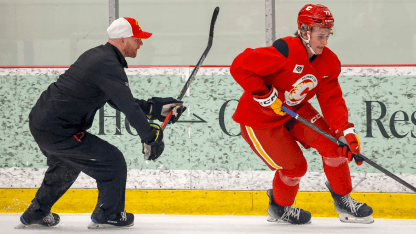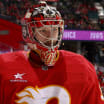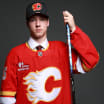It’s safe to say the Flames prioritized the centre position at this year’s NHL Draft in Los Angeles.
General Manager Craig Conroy and his staff selected centres with each of their first three selections, adding promise and depth to their forward ranks with the additions of Cole Reschny, Cullen Potter and Theo Stockselius.
Conroy navigated the middle of the ice during his NHL career, and he’s got another longtime centre acting as a helping hand for his three new charges.
And that’s exactly what Skills Consultant Matt Stajan did earlier this month, when the Flames welcomed Reschny, Potter, Stockselius and 21 other prospects to Development Camp at WinSport.
“You get a feel of what it’s like this week, and then you kind of know what to expect when you come back for training camp,” Stajan relayed between Development Camp drills earlier this month. “These weeks are important; I think all the teams put a lot of time and effort into it for that reason, because the league is getting younger and younger.
“But at the same time, it’s a process. You come in, this is the first step. You give them some tools, some advice, and hopefully, they’re sponges and they take it.”
A player like Stajan could act as a valuable asset for Calgary’s three new pivots. He logged more than 1,000 games in the NHL with the Flames and Maple Leafs and understands the finer points of the position as well as its overall importance.
“I think it’s very important, I might be a little biased because I was a centreman, but as a centreman, every faceoff, you’re taking charge at the start of that shift,” said Stajan. “The game’s so fast now, that wingers are switching, and sometimes they’re switching positions depending on the play and what the read is, but as a centreman, you’re taught to support the puck all over the ice.
“If guys are doing it at the junior level, or wherever they came from, they’ve had that experience and you want that to continue to develop. Obviously, the game gets faster and faster as you get older and go level to level, but as a centre, you need to be that safety valve, that support player that can distribute the puck, but also drive the play.”
Reschny is coming off a 92-point campaign in the WHL, one that saw the Victoria Royals capture their first division title in nine years, while Potter was one of the youngest skaters in NCAA hockey in 2024-25, patrolling the middle of the rink at Arizona State.
The two first-rounders (Reschny went 18th overall, Potter 32nd) are quick, and from Stajan's very early in-person impressions, the pair are quick thinkers, too.
“They’ve got good heads on their shoulders and they’ve got that drive, and they want to put in the work; you can see that they’re smart players,” he explained. “You can just tell they have that poise, they have that ability to think the game. And then, their speed; it’s no secret that - especially Potter - you’ve heard about that speed, that first step, and both guys are guys that can make plays.
“They’re fresh in the organization, it’s exciting for everybody, and I think it’s our job to continue to help them and give them the tools to keep growing their game, so that when the time’s right - and hopefully it’s sooner rather than later - they make that next step to the next level.
“Hopefully, they’re part of this organization for a long time and what we want to build here.”
Stockselius, too, is coming off a big year, scoring 22 goals in 40 games in Sweden’s top junior circuit.
The 6-foot-2 forward attended the NHL Combine in Buffalo in June, then returned to North America to take part in Development Camp in Calgary.
The second-rounder is the tallest of the Flames’ three new centremen, and Stajan is optimistic that the trio will push each other as they continue to develop into pros.
Players that - if all goes according to plan - Calgary fans will be able to root for well into the future.
“You put more players in and it creates competition, but you hope they progress and you hit on those picks,” said Stajan. “All these kids want to play in the NHL, everyone at the draft wants to play in the NHL.
“You help them, and you hope they have the drive to become what everybody wants them to be. The more stock you have, I think creates that internal competition and gives you more of an opportunity - just law of percentages - that you’re going to get some quality NHL players for a long time.”



















